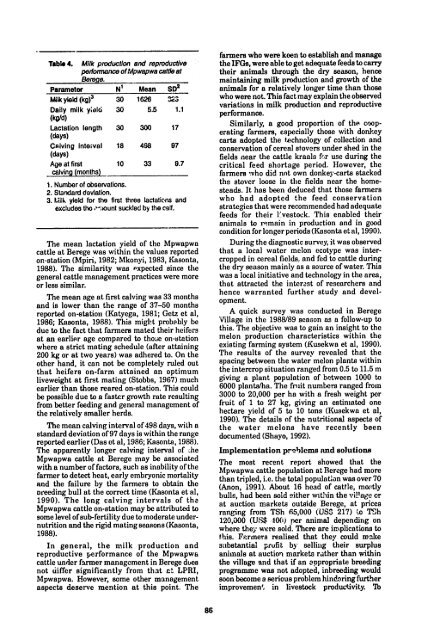aistand south~ern afrkca - (PDF, 101 mb) - USAID
aistand south~ern afrkca - (PDF, 101 mb) - USAID
aistand south~ern afrkca - (PDF, 101 mb) - USAID
Create successful ePaper yourself
Turn your PDF publications into a flip-book with our unique Google optimized e-Paper software.
Table 4. Milk production and reproductive<br />
peronnanceofMpwapwa cattle at<br />
Bereg/.<br />
SD 2<br />
Parameter N' Mean<br />
Milk yield (kg) 3<br />
30 1626 .3<br />
Daily milk yisld 30 5.5 1.1<br />
(kg/d)<br />
Lactation length 30 300 17<br />
(days)<br />
Calving Interval 18 498 97<br />
(days)<br />
Age at first 10 33 9.7<br />
calving (months)<br />
1. Nu<strong>mb</strong>er of observations.<br />
2. Standard deviation,<br />
3. Mill yield for the first three lactaticas and<br />
excludes tho ,,',ount suckled by the calf.<br />
The mean lactation yield of the Mpwapwa<br />
cattle at Berege was within the values reported<br />
on-station (Mpiri, 1982; Mkonyi, 1983, Kasonta,<br />
1988). The similarity was expected since the<br />
general cattle management practices were more<br />
or less similar.<br />
The mean age at first calving was 33 months<br />
and is lower than the range of 37-50 months<br />
reported on-station (Katyega, 1981; Getz et al,<br />
1986; Kasonta, 1988). This might probobly be<br />
due to the fact that farmers mated their heifers<br />
at an earlier age compared to thoue on-station<br />
where a strict mating schedule (after attaining<br />
200 kg or at two years) was adhered to. On the<br />
other hand, it can not be completely ruled out<br />
that heifers on-farm attained an optimum<br />
liveweight at first mating (Stobbs, 1967) much<br />
earlier than those reared on-station. This could<br />
be possible due to a faster growth rate resulting<br />
from better feeding and general management of<br />
the relatively smaller herds.<br />
The mean calving interval of498 days, witha<br />
standard deviation of 97 days is within the range<br />
reported earlier (Das et al, 1986; Kasonta, 1988).<br />
The apparently longer calving interval of .he<br />
Mpwapwa cattle at Berege may be associated<br />
with a nu<strong>mb</strong>er of factors, such as inability of the<br />
farmer to detect heat, early e<strong>mb</strong>ryonic mortality<br />
and the failure by the farmers to obtain the<br />
oreeding bull at the correct time (Kasonta et al,<br />
1990). The long calving intervals of the<br />
Mpwapwa cattle on-station may be attributed to<br />
some level of sub-fertility due to moderate undernutrition<br />
and the rigid mating seasons (Kasonta,<br />
1988).<br />
In general, the milk production and<br />
reproductive performance of the Mpwapwa<br />
cattle under farmer management in Berege does<br />
not differ significantly from that et LPRI,<br />
Mpwapwa. However, some other management<br />
aspects deserve mention at this point. The<br />
86<br />
farmers who were keen to establish and manage<br />
the IFGs, were able to get adequate feeds to carry<br />
their animals through the dry season, hence<br />
maintaining milk production and growth of the<br />
animals for a relatively longer time than those<br />
who were not. This fact may explain the observed<br />
variations performance. in milk production and reproductive<br />
Similarly, a good proportion of the cooperating<br />
farmers, especially those with donkey<br />
carts adopted the technology of collection and<br />
conservation of cereal stovers under shed in the<br />
fields near the cattle kraals fRr use during the<br />
critical feed shortage period. However, the<br />
farmers who did not own donkey-carts stacked<br />
the stover loose in the fields near the homesteads.<br />
It has been deduced that those farmers<br />
who had adopted the feed conservation<br />
strategies that were recommended had adequate<br />
feeds for their 'vestock. This enabled their<br />
animals to remain in production and in good<br />
condition for longer periods (Kasonta et al, 1990).<br />
During the diagnostic survey, it was observed<br />
that a local water melon ecotype was intercropped<br />
in cereal fields, and fed to cattle during<br />
the dry season mainly as a source of water. This<br />
was a local initiative and technology in the area,<br />
that attracted the interest of researchers and<br />
hence warranted further study and development.<br />
A quick survey was conducted in Berege<br />
Village in the 1988/89 season as a follow-up to<br />
this. The objective was to gain an insight to the<br />
melon production characteristics within the<br />
existing farming system (Kusekwa et al, 1990).<br />
The results of the survey revealed that the<br />
spacing between the water melon plants within<br />
the intercrop situation ranged from 0.5 to 11.5 m<br />
giving a plant population of between 1000 to<br />
6000 plants/ha. The fruit nu<strong>mb</strong>ers ranged from<br />
3000 to 20,000 per ha with a fresh weight per<br />
fruit of 1 to 27 kg, giving an estimated one<br />
hectare yield of 5 to 10 tons (Kusekwa et al,<br />
1990). The details of the nutritional aspects of<br />
the water melons have recently been<br />
documented (Shayo, 1992).<br />
Implementation priblems and solutions<br />
The most recent report showed that the<br />
Mpwapwa cattle population at Berege had more<br />
than tripled, i.e. the total populatlon was over 70<br />
(Anon, 1991). About 16 head of cattle, momtly<br />
bulls, had been sold either within the vi!age er<br />
at auction markets outside Berege, at prices<br />
ranging from TSh 65,000 (US$ 217) o T.Sh<br />
120,000 (US$ t100) per animal depending on<br />
where they were sold. There are implications to<br />
this. Fprmers realised that they could mauke<br />
substantial profit by selling their surplus<br />
animals at auction markets rather than within<br />
the village and that if an oppropriate breeding<br />
programme was not adopted, inbreeding would<br />
soon become a serious problem hind.ring further<br />
improvemen', in livestock productivity. To

















